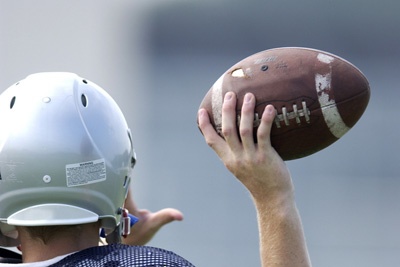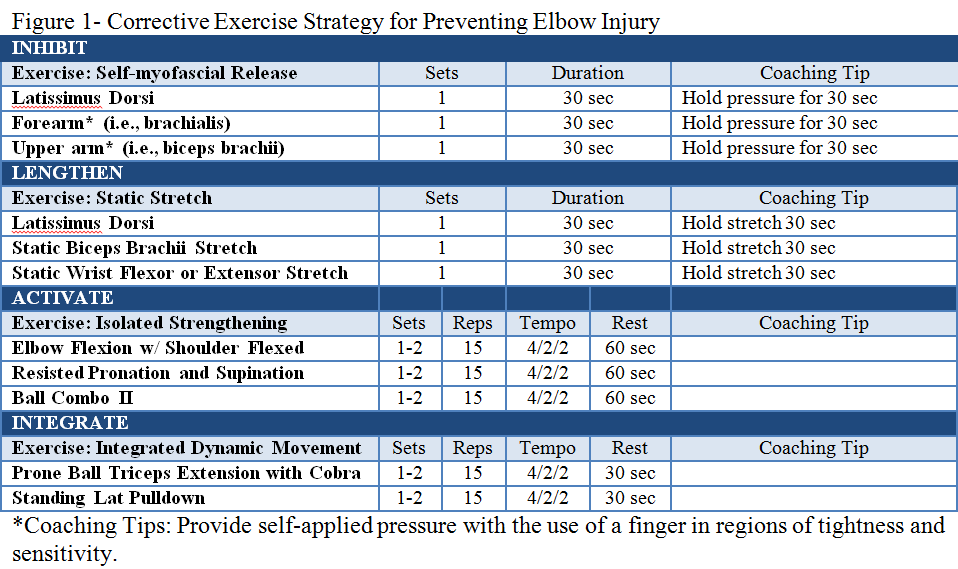
By Sam Hutchison NASM-CPT, CES, PES
"In today’s highly competitive sports environment, elbow injuries are prevalent for overhead throwing athletes (i.e., baseball and football) at all levels of playing. Although this may be as mild as a sore elbow, it can further degrade into a more serious elbow injury such as a ruptured elbow ligament; in particular the ulnar collateral ligament (UCL)." Ruptures to the UCL have been seen in 1 in 9 major league baseball pitchers since 2001 and requires reconstructive surgery popularly known as Tommy John surgery (1). Tommy John surgery does offer an 85% success rate, but a daunting 12-18 month recovery process follows the surgery, which can be difficult for any athlete eager to get back into action (1, 2). As a fitness professional, it is important to understand the basic mechanisms and signs of elbow injuries and refer to a licensed physician for diagnosis and treatment if an injury is ever suspected.
Mechanism of Injuries
Throwing technique for each throwing sport differs slightly, but throwing mechanics are typically broken down into six phases (3):
- Wind up: Initial movement beginning when elevating the leg contralateral (opposite) of the throwing arm allowing for greater momentum. The center of gravity and stability is kept on the stance leg.
- Early cocking: The elevated leg strides forward and the throwing arm moves into the throwing position allowing for a transfer of force from the upper extremity to the lower extremity.
- Late cocking: Both feet have contact on the ground and the shoulder begins to externally rotate and the elbow flexes. A greater degree of shoulder external rotation enables the athlete to take advantage of the myostatic (stretch) reflex and subsequently results in greater power and ball velocity.
- Acceleration: The ball is released after the shoulder undergoes rapid internal rotation and the elbow extends.
- Deceleration: The shoulder undergoes maximal internal rotation after the ball is released.
- Follow through: The body continues to move forward until arm motion has stopped.
When throwing, the elbow undergoes extension and the distal (furthest away portion) of the elbow joint angulates outward (known as elbow valgus). Elbow injuries typically occur during the late cocking and acceleration phase when the UCL is unable to counteract the extreme valgus and elbow extension created (1,4). Typically the UCL alone is unable to counteract the extreme forces placed on it by throwing. The muscles involved with shoulder internal rotation and forearm pronation are responsible to help counteract these forces and stabilize the elbow. If these muscles become too fatigued or there is a preexisting shoulder injury, an excessive amount of force is placed on the UCL, thus increasing the risk of injury (5, 6).
Risk Factors
Elbows injuries can occur through both chronic and acute trauma however, they typically occur through overuse. A survey looking at 95 youth baseball pitchers (50 with elbow surgery, 45 without elbow surgery) indicated that players who underwent elbow surgery had pitched more months throughout the year, games per year, innings per game, pitches per game and pitches at a higher speed (7). It was also indicated that these injured pitchers had used more aggressive post game recovery protocol such as icing and medicating with anti-inflammatory medication (5).
Along with overuse, another risk factor for elbow injury identified through research is range of motion deficits. A study conducted amongst baseball players with and without a history of elbow, shoulder and spinal injuries measured their passive range of motion (6). Each subject underwent a battery of assessments measuring the range of motion in their throwing arm for elbow flexion, elbow extension, shoulder internal rotation, shoulder external rotation and forearm pronation and supination. Results indicated injured players exhibited decreased internal rotation of the shoulder while exhibiting no significant difference in elbow and forearm range of motion (6).
What We’ve Learned
While the advancement in treatment measures has been shown to be effective at rehabilitating elbow injuries, it isn’t a magic bullet. A well devised exercise program to help prevent such injuries will always be the most viable option for keeping athletes healthy at any level. Fitness professionals should strive to assess their client’s joint range of motion through the use of various assessments and provide a pragmatic exercise program to address any potential muscle imbalances throughout the kinetic chain. It is important not to completely hone in on just the elbow but instead the entire human kinetic chain (wrist, shoulder, spine/core, lower extremities) etc.) to build a strong and balanced athlete to withstand the rigors of any sport.
A comprehensive corrective exercise strategy following NASM’s Corrective Exercise Continuum includes:
- Inhibitory techniques (i.e., self-myofascial release) to decrease tightness and alleviate trigger points found in overactive muscles.
- Lengthening (i.e., static and neuromuscular stretching) techniques to restore optimal range of motion of overactive (tight) muscles.
- Isolated strengthening exercises to improve neuromuscular activation of underactive muscles through a controlled range of motion.
- Integrated (total-body) exercises to integrate the entire kinetic chain through multijoint, compound movements.
Figure 1 provides an example a corrective exercise strategy for the elbow. Please refer to NASM’s Corrective Exercise Specialist (CES) course for a comprehensive list of movement assessments and corrective exercise strategies for the elbow.

References
1. Langer P, Fadale P, M Hulstyn. Evolution of the treatment options of ulnar collateral ligament injuries of the elbow. Br J Sport Med. 2006; 40:499-506.
2. Wilk KE, Reinold MM, Andrews JR. Rehabilitation of the thrower’s elbow. Clin Sports Med. 2004; 23: 765-801.
3. Seroyer ST, Nho SJ, Bach BR, Bush-Joseph CA, Nicholson GP, Romeo AA. The Kinetic Chain in Overhand Pitching. Sports Health. 2010; 2(2):135-146.
4. Cain EL, Dugas JR, Wolf RS, Andrews JR. Elbow Injuries in Throwing Athletes. Am J Sport Med. 2003; 31(4): 621-635.
5. Olsen SJ, Fleisig GS, Dun S, Loftice J, Andrews JR. Risk Factors for Shoulder and Elbow Injuries in Adolescent Baseball Pitchers. Am J Sport Med. 2006; 34(6):905-912.
6. Dines JS, Frank JB, Akerman M, Yocum LA. Glenohumeral Internal Rotation Deficits in Baseball Players With Ulnar Collateral Ligament Insufficiency. Am J Sport Med. 2009; 37(3): 566-570.
7. Bernas GA, Thiele RA, Kinnaman KA, Hughes RE, Miller BS, Carpenter JE. Defining Safe Rehabilitation for Ulnar Collateral Ligament Reconstruction of the Elbow. Am J Sport Med. 2009;37(12) 2392-2400.











